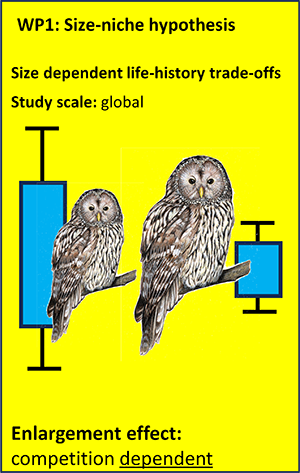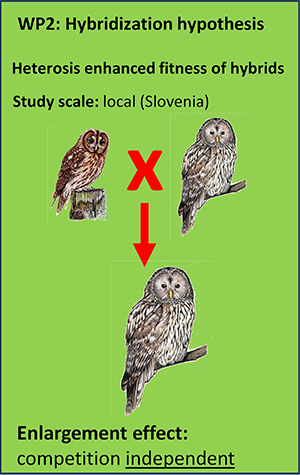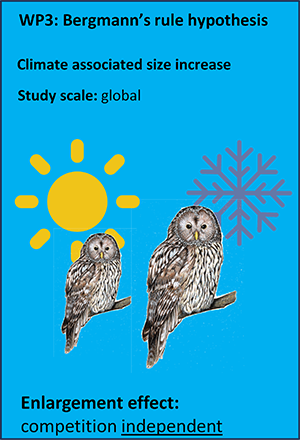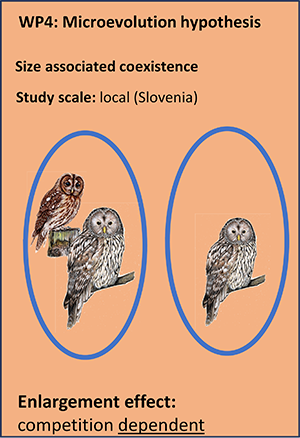Projects
The purpose of the investment project BTH-NIB is the assurance of the appropriate infrastructural conditions for the use of research and developmental opportunities in the fields of operation of the NIB.
Play Video About project Publication
CO-STRIX
Project coordinator: assist. prof. dr. Al Vrezec
Code: J1-60010
Duration: 1. 1. 2025 – 31. 12. 2026
Evolutionary effects of competition in coexisting apex predator populations (CO-STRIX)
Information about the project - SICRIS
The CO-STRIX project is one of the first studies to address the evolutionary effects of interactions between apex predators. The project, fully funded by ARIS, was broad and complex in scope, but the ARIS has been halved the project and will therefore be implemented on a significantly reduced scale. The focal study species, the Tawny Owl (Strix aluco) and the Ural Owl (Strix uralensis), are closely related and highly competitive species. According to our preliminary data interspecific interactions appear to promote micro-evolutionary changes in body size due to altered selection pressures. Similar size differentiation pattern was found at the larger scale with Ural Owls sympatric with the Tawny Owl tend to be larger than in allopatric populations, suggesting certain pattern of character displacement due to competition.
The main hypothesis is: The competition with the Tawny Owl drives sympatric Ural Owls to larger body size in order to keep competitive dominance in space and nest-site utilization. However, to corroborate or reject main hypothesis the objectives of the present proposal are to study all possible mechanisms that could result in such size differentiation in larger Ural Owl. We set up several additional supporting hypotheses to rule out and explore alternative explanations, but according to reduced financing all envisaged hypotheses cannot be tested, therefore only the following hypotheses will be taken into account shaped as work packages:
WP1: Size-niche hypothesis
 While larger size enables higher competitive dominance, the smaller size enables higher general fitness due to lower energy cost, higher hunting agility and higher adaptability to changing environment. Larger size is beneficial only in highly competitive environments due to the trade-offs of competitive dominance over adaptability trait. Corroboration of this hypothesis would directly support the character displacement hypothesis due to competitive dominance.
While larger size enables higher competitive dominance, the smaller size enables higher general fitness due to lower energy cost, higher hunting agility and higher adaptability to changing environment. Larger size is beneficial only in highly competitive environments due to the trade-offs of competitive dominance over adaptability trait. Corroboration of this hypothesis would directly support the character displacement hypothesis due to competitive dominance.
Hypothesis: If competition is an ultimate factor in increasing body size, then other life-history trade-offs should be negatively or not affected at all in populations with larger sized individuals.
Activities and methods: The study conducted as part of this WP will be a review of the published life history traits of the Ural Owl from different parts of the species' range. We have recently published a similar study for the Tawny Owl (Ratajc et al. 2023, Sci Tot Env), which will serve as a model study for the creation of a comparative database on the life- history traits of the Ural Owl. We will analyse the following life history parameters: diet (see also the trans-European comparative study Vrezec et al. 2018, Bird Study), population density, habitat and productivity (clutch size), which have also been most commonly studied and reported for the Tawny Owl (Ratajc et al. 2023, Sci Tot Env).
WP2: Hybridization hypothesis
 Interspecific horizontal gene flow can contribute—due to heterosis—to a larger size in a species that is more prone to hybridization. In the scope of this project we will search for evidence of hybridization between Tawny and Ural Owl in the wild, but effects of hybridization on the body size will remain open for future research due to reduced financing.
Interspecific horizontal gene flow can contribute—due to heterosis—to a larger size in a species that is more prone to hybridization. In the scope of this project we will search for evidence of hybridization between Tawny and Ural Owl in the wild, but effects of hybridization on the body size will remain open for future research due to reduced financing.
Activities and methods: In this WP we will focus on the study of hybridization and introgression between Ural and Tawny Owl, in particular whether these two species hybridise in Slovenia and what is the degree of introgression from the Tawny Owl into the Ural Owl. We will use double digest Restriction Associated DNA Sequencing protocol (ddRADseq; Peterson et al. 2012, PLOS ONE) to determine the genetic structure of the Tawny and Ural Owl and their putative hybrids. We will primarily collect fresh blood or tissue samples from Ural Owls and their putative hybrids (large individuals) in Slovenia, and to a lesser extent from Tawny Owl (~20%). Samples will be collected only from fully grown live or available dead individuals. Samples will be processed according to Baltazar-Soares et al. (2024; Mol Ecol) and sequenced in an external facility. In addition to the Slovenian samples, we will also include pure reference populations – Tawny Owl from Portugal and Ural Owl from Japan. One of the critical constraints associated with ddRADseq is the need for a reference genome for mapping the RADseq reads. We will map all our samples to the Tawny Owl whose reference genome is known from the Vertebrate Genome Project and also from Baltazar-Soares et al. (2024; Mol Ecol); the reference genome for the Ural Owl is not yet known according to GoaT. Based on the molecular results, we will classify the specimens into non-hybrids, F1 hybrids and hybrids of later cross generations.
WP3: Bergmann’s rule hypothesis
 According to Bergmann’s rule, homoeothermic animals tend to be larger in colder climates, while individuals in similar climates would exhibit similar size patterns. Rejection of this hypothesis would provide partial support for the character displacement hypothesis due to competitive dominance.
According to Bergmann’s rule, homoeothermic animals tend to be larger in colder climates, while individuals in similar climates would exhibit similar size patterns. Rejection of this hypothesis would provide partial support for the character displacement hypothesis due to competitive dominance.
Hypothesis: If larger individuals across Ural Owl distribution range are associated with cooler climates and smaller individuals with warmer climates, this means that the Ural Owl body size responds to abiotic environmental conditions rather than to biotic environmental influences.
Activities and methods: This WP aims to improve our understanding of how climate shapes morphological traits in birds. To this end, we will build a comprehensive morphological dataset and analyze it in conjunction with abiotic microclimatic data. We will structure the work in three phases. First, we will collect and annotate a database of observed and measured samples of the Ural Owl. The aim is to create a georeferenced database with locations and samples of known size. We will collect the data from museum collections (Ljubljana, Vienna, Sarajevo, Helsinki, Stockholm, Tring) and citizen science databases, including ringing data, where data are collected from existing Ural Owl monitoring programs, which in Europe cover half of the countries where the species breeds (Derlink et al. 2018, Bird Study). Subsequently, we will collect accurate microclimatic data for all known geolocated samples. The idea behind biophysical modeling of exact microclimatic data is that in this way we can obtain accurate temperatures at the perch locations of the animals. In addition to temperatures, we will also obtain data on humidity and wind speed. Microclimatic modeling will be performed in the R software environment using the packages NichemapR (Kearney & Porter 2017, Ecography; Kearney et al. 2020, Methods Ecol Evol) and microclima (Maclean et al. 2019, Methods Ecol Evol) connected to the Era5 climate dataset Hersbach et al. 2020, Q J Royal Meteo Soc; Klinges et al. 2022, Methods Ecol Evol), which refers to data from 1940 onwards. The strength of such an approach is the inclusion of abiotic elements such as slope, elevation and orientation in the modelling of temperatures experienced, providing a solid basis for understanding the precise conditions to which the animals are exposed. We will statistically evaluate the differences in these abiotic factors across the latitudinal range of sites studied. After confirming the differences in the proposed abiotic factors, we will investigate the potential effects of these abiotic factors on animal size.
WP4: Microevolution hypothesis
 At local scale, character displacement due to competitive dominance should lead to heritable microevolutionary changes in strong competitive environments by out selecting smaller individuals exclusively in areas of most intensive competition. Corroboration of this hypothesis would directly support the character displacement hypothesis due to competitive dominance.
At local scale, character displacement due to competitive dominance should lead to heritable microevolutionary changes in strong competitive environments by out selecting smaller individuals exclusively in areas of most intensive competition. Corroboration of this hypothesis would directly support the character displacement hypothesis due to competitive dominance.
Hypothesis: If competition plays a detrimental role in selection of Ural Owl individuals in the areas of close coexistence with Tawny Owl, it is expected that successfully breeding Ural Owls of smaller size would be present only in unshared territories with no direct competition for nest sites and space and missing on heterospecific shared territories.
Activities and methods: The study will be conducted in study areas with an established nest box network in Slovenia. In spring, each nest box will be checked for owl broods, and adult females and males will be trapped to be measured and ringed. In addition, each site will be examined for territorial Tawny and Ural Owls to determine whether the territories are shared or not. The proven playback method will be used, which is a reliable method for assessing owl territories (Vrezec & Bertoncelj 2018, Bird Study). The fieldwork will be partly carried out using the help of citizen science capacities of the Slovenian Bird Ringing Centre. The biometric data (wing length, selected bone lengths and weight) of all breeding owls will be collected for both sexes.
Dissemination
Due to reduced financing the dissemination activities will be reduced to mainly scientific publications. The project is structured in such a way that each WP will produce a scientific output - a paper. Due to the relatively short project duration, two papers will be published by the end of the project, while the other two will be prepared by the end of the project and published in the post-project period.


 Scope of NIB's accreditation is given in the Annex to the accreditation certificate and in the List of accredited methods for detection of GMOs and microorganisms – plant pathogens
Scope of NIB's accreditation is given in the Annex to the accreditation certificate and in the List of accredited methods for detection of GMOs and microorganisms – plant pathogens 
